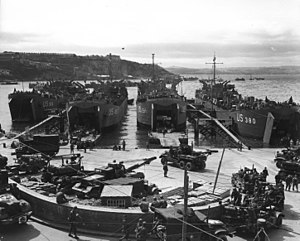 LST-380 loading on 1 June 1944, alongside other ships LST-380 loading on 1 June 1944, alongside other ships
| |
| History | |
|---|---|
| Name | USS LST-380 |
| Builder | Bethlehem Steel Company, Quincy, Massachusetts |
| Laid down | 10 December 1942 |
| Launched | 10 February 1943 |
| Commissioned | 15 February 1943 |
| Decommissioned | 7 June 1946 |
| Stricken | 19 July 1946 |
| Honours and awards | 3 battle stars (WWII) |
| Fate |
|
| Name | HM LST-380 |
| Acquired | 20 November 1944 |
| Commissioned | 20 November 1944 |
| Fate | Returned to US Navy, April 1946 |
| General characteristics | |
| Class and type | LST-1-class tank landing ship |
| Displacement |
|
| Length | 328 ft (100 m) |
| Beam | 50 ft (15 m) |
| Draft |
|
| Propulsion | 2 × General Motors 12-567 diesel engines, two shafts, twin rudders |
| Speed | 12 knots (22 km/h; 14 mph) |
| Range | 24,000 nmi (44,000 km) at 9 kn (17 km/h; 10 mph) |
| Boats & landing craft carried | 2 × LCVPs |
| Troops | 163 |
| Complement | 111 |
| Armament | |
USS LST-380 was a LST-1-class tank landing ship of the United States Navy during World War II, later loaned to the Royal Navy.
LST-380 was laid down on 10 December 1942 at Quincy, Massachusetts, by the Bethlehem Steel Company; launched on 10 February 1943; sponsored by Mrs. D. J. Callahan; and commissioned on 15 February 1943.
During World War II, LST-380 was assigned to the European theater and participated in the following operations:
- Sicilian occupation — July 1943
- Salerno landings — September 1943
- Invasion of Normandy — June 1944
LST-380 was transferred to the United Kingdom on 20 November 1944 and returned to United States Navy custody on 11 April 1946. On 7 June 1946, the tank landing ship was sold to the United States Military Government, Korea, and struck from the Navy list on 19 July 1946.
LST-380 earned three battle stars for World War II service.
M/V Salvage Chief
In 1948, Fred Devine of Portland, Oregon purchased the ex-LSM-380 to convert it for shallow-water salvage work. The bow doors were welded shut, extra anchor winches and anchors were added, and a helipad built on the aft deck. Renamed Salvage Chief and based in Astoria, Oregon, the ship assisted in rescue and recovery operations along the Pacific Coast from 1949 to 2015. Notable salvage operations included the SS Yorkmar in 1952, the SS Sansinena in 1976, and the Exxon Valdez in 1989. In 2016, the ship was sold to Salvage Chief LLC and remains in Astoria for training.
References
- Photo gallery of LST-380 at NavSource Naval History
 This article incorporates text from the public domain Dictionary of American Naval Fighting Ships. The entry can be found here.
This article incorporates text from the public domain Dictionary of American Naval Fighting Ships. The entry can be found here.
- ^ "Salute to M/V Salvage Chief" (PDF). National Maritime Historical Society. 2018. Retrieved 3 May 2021.
- "Salvage Chief could get new life after a disaster". The Daily Astorian. 6 February 2019. Retrieved 3 May 2021.
External links
This article about a specific ship or boat of the United States Armed Forces is a stub. You can help Misplaced Pages by expanding it. |
- LST-1-class tank landing ships of the United States Navy
- Ships built in Quincy, Massachusetts
- 1943 ships
- World War II amphibious warfare vessels of the United States
- LST-1-class tank landing ships of the Royal Navy
- World War II amphibious warfare vessels of the United Kingdom
- United States naval ship stubs